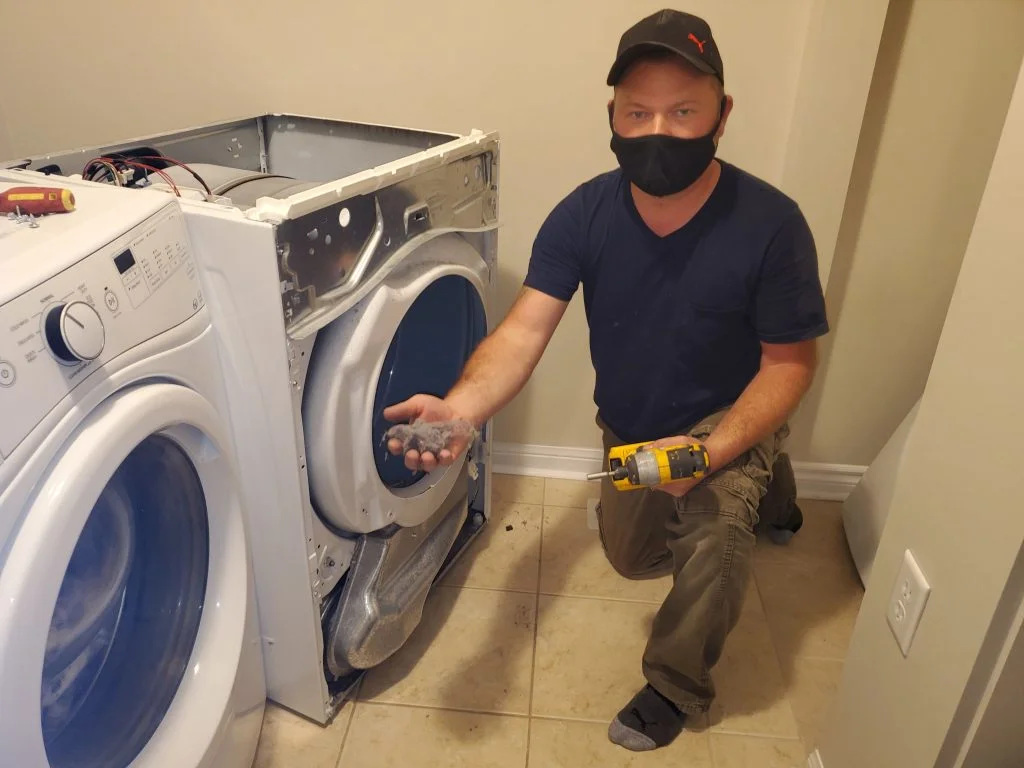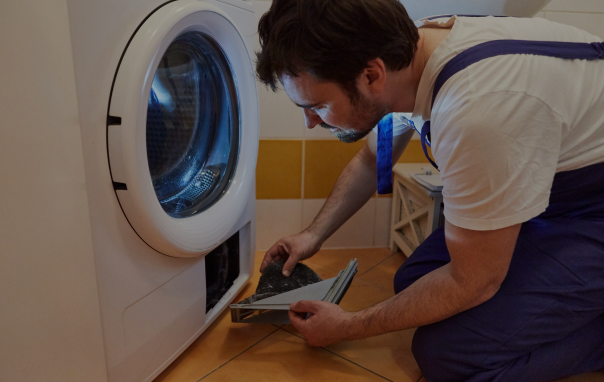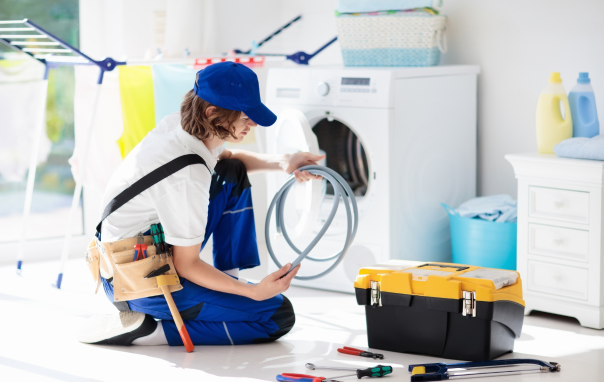10 Common Washing Machine Problems and How to Fix Them

A washing machine is one of the most essential household appliances, making daily life easier by handling piles of laundry and freeing up valuable time. However, as with any major household appliance, problems can arise and disrupt your routine. From strange noises to water leaks and spinning failures, each issue can become a significant inconvenience if not addressed promptly. In this comprehensive guide, we’ll explore 10 common washing machine problems, explain why they occur, and show you how to fix them. Whether you use a Samsung, Bosch, or Frigidaire washer, these solutions will help you maintain optimal performance and prevent more expensive repairs down the line.

Identify Common Washing Machine Problems
From drainage issues to excessive noise, recognizing problems early can prevent costly repairs. Below, we discuss common washing machine issues and their solutions.
Washing Machine Won’t Start
A non-starting washer is one of the most frequent washing machine issues faced by customers. The problem may stem from a simple oversight or a more complex malfunction.
Check the Power Supply
Ensure the washing machine is plugged into a functional power outlet. Check the circuit breaker and reset if necessary.
Inspect the Door Lock
A faulty door lock or lid switch can prevent the washer from starting. If the door lock mechanism is broken, replacing it is necessary.
Examine the Control Settings
Make sure the control panel is not locked or in a delayed start mode. Resetting the electronic panel might help resolve the issue.
Washing Machine Fails to Drain
A washing machine that doesn’t drain can leave your clothes soaked and your laundry schedule in disarray.
Clear the Drain Hose
A clogged drain hose is a common cause of drainage issues. The drain hose could be clogged or kinked, preventing water from flowing out. Check for visible blockages and straighten any twists. A drain pump could also be the culprit—if broken or clogged, it can disrupt the draining cycle.
Inspect the Pump Filter
A clogged pump filter can prevent water from draining properly. Clean the filter regularly to avoid pump failures.
Unusual Noises During Operation
Strange noises—rattling, grinding, or squeaking—often signal deeper issues. These sounds can be distracting and potentially indicate parts are wearing down.
Diagnose Grinding or Scraping Sounds
Grinding sounds can point to a broken belt, worn bearings, or an internal object stuck between the drum and the tub. Skilled technicians can remove the drum assembly to check for foreign objects or bearing failures.
Addressing Loud Vibrations
Loud vibrations are often caused by unbalanced loads or incorrectly adjusted leveling legs. Over time, excessive shaking can damage the internal mechanisms of your washer. Redistribute clothes or adjust the legs to eliminate the vibration.
Off-Balance Loads and Vibrations
Unbalanced loads create significant noise and can also lead to premature wear on the machine’s internal components, like the pump or agitator.
Redistributing the Load
Spreading out heavy items, such as jeans or towels, can help maintain equilibrium. Overloading the drum can also cause violent shaking. For best results, follow manufacturer guidelines for load size.
Adjusting the Leveling Feet
If the washer is off balance, it may rock during a spin cycle. Adjust the leveling feet, typically found at the bottom corners, until the machine is stable. This process ensures an even wash cycle and helps prevent further structural damage.
Leaking Water Issues
A water leak can lead to water damage in your kitchen or laundry area. Promptly identifying the source can help you avoid mold growth and potential floor damage.
Inspecting Hoses and Connections
Check the inlet hoses for cracks or loose connections that could cause a leak. The drain hose might also be loose, leading to a water leak during drainage. Tighten or replace any worn parts to stop further damage.
Checking the Detergent Drawer
An overflowing detergent drawer can cause leaks if you use too much detergent or if the dispenser is clogged with residue. Clean the drawer thoroughly with warm water, removing any soap buildup that might block water flow.
Washing Machine Won’t Spin or Agitate
When your washer fails to spin or agitate, clothes remain soggy, and the cycle doesn’t complete efficiently.
Inspecting the Drive Belt
Many washers rely on a belt to rotate the drum. A broken belt or one that’s slipped off the pulley will prevent the machine from spinning. Replacing or reseating the belt can restore movement.
Reviewing the Lid Switch Assembly
Top-load washers feature a lid switch that signals the machine to start spinning only when the lid is securely closed. If this switch is malfunctioning, the spin cycle won’t engage. Professional technicians can diagnose and replace the lid switch if needed.
Front Loader Specific Problems
Maintaining the Door Seal
Front-load machines often face mold or mildew buildup around the door seal. This can trap moisture and lead to unpleasant odors. Wipe the seal dry after each cycle and leave the door slightly ajar to help moisture evaporate.
Addressing Suds Lock
Using too much or incorrect detergent can create excessive suds, known as “suds lock,” inhibiting the washer’s ability to drain properly. Reduce the detergent amount or switch to a High-Efficiency formula if your machine demands it.
Top Loader Unique Issues
Resolving Agitator Problems
In a top-load washer, the agitator’s role is crucial for cleaning clothes effectively. If the agitator doesn’t move or only spins partially, the agitator dogs or couplings might be worn. Replacing them often resolves the lack of movement.
Dealing with a Stuck Lid
A stuck lid may be the result of a faulty lock mechanism or control board. If you can’t access the drum, a licensed technician may need to reset or replace the lock assembly or override the manual release.
Preventive Maintenance Tips
Regular upkeep can help you avoid many of these common issues and keep your washing machine performing well for years to come.
Regular Cleaning of Filters and Hoses
Lint, pet hair, and debris can clog the machine’s filters and hoses over time. Clean them periodically to prevent drain problems and pump issues.
Utilizing the Right Detergent
Always use a detergent recommended for your washer type (HE or conventional). Excess soap can cause buildup and lead to cleaning inefficiency.

Why Choose Toronto Refrigeration for Washing Machine Repairs?
At Toronto Refrigeration, our team of expert technicians provides professional repairs for all major appliance brands. We offer same-day washing machine repair service, ensuring efficient service at competitive rates. Our appliance repair experts handle washer repairs, dryer repair services, dishwasher repair service, and fridge repair. Whether it’s an emergency washing machine repair or regular appliance service, we provide reliable washer repairs at affordable prices. Book an appointment online today for quality appliance repair services with no extra charge. Whether you need drain pump maintenance or a full spin cycle overhaul, our team’s skilled technicians are equipped to tackle any washer problem.
Conclusion
Washing machine issues can disrupt your laundry routine, but understanding common washing machine problems can help you troubleshoot them effectively. Whether it’s drainage issues, a faulty control panel, or excessive noise, addressing these problems early can save you from costly repairs. For professional appliance repair services, trust Toronto Refrigeration for dependable washing machine repair and quality service. Our licensed technicians provide upfront estimates, honest assessments, and fair pricing. Schedule a service appointment today for exceptional services and complete satisfaction!